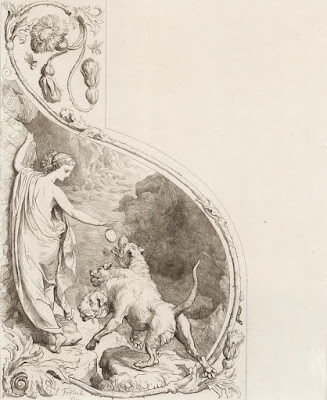Lorenz
Frölich (aka Lorenz Frølich) (1820–1908)
“Psyche feeding Cerberus”, 1862, from the series, “Amor and Psyche”,
published by Pierre Jules Hetzel (1814–1886)
Etching in brown ink with light plate tone on wove paper
Size: (sheet) 38.5 x 32.3 cm; (plate) 36.8 x 31 cm; (image
borderline) 26.7 x 16.3 cm
Inscribed on plate within the image borderline at lower edge left
of centre: “L Frolich / 1862”
Ref: Lotte Thrane 2008, ''Tusmørkemesteren'', Vandkunsten,
Copenhagen.
Proof state impression before the addition of inscribed text for
publication.
Condition: a crisp and near faultless impression in excellent
condition (i.e. there are no tears, holes, folds, stains, foxing or significant
signs of use), with small margins and laid upon an archival support sheet.
I am selling this extremely rare proof state (before publication) impression
by the famous illustrator of children’s books for AU$210 (currently US$139.21/128.20/GBP107.43 at the time of posting this
listing). Postage for this print is extra and will be the actual/true cost.
If you are interested in purchasing this finely executed and
elegant etching, please contact me (oz_jim@printsandprinciples.com) and I will
send you a PayPal invoice to make the payment easy.
Looking at this very refined composition with the “right”
pictorial components to hook a viewer’s attention and to sustain close
examination helps to explain why the name of the artist who executed it, Frölich,
became so famous in the 19th century that a by-word for children’s
books was simply: "un froelich" (see http://www.dodedans.com/Efroelich.htm).
For those unfamiliar with the scene portrayed here of Psyche
tossing a cake to the mythological three-headed dog, Cerberus, her action was an
act of survival rather than a good-natured dog-loving gesture. Essentially, Psyche
is pacifying this guardian dog of Hades, so that she may cross the River
Styx—shown below the rock ledge that she is navigating her way around—and gain
entry into the underworld.
What I like about this composition is that the serpentine rhythm followed
by the decorative “S”-shaped stem of the thistle (I hope that I am right about
this being a thistle!) helps to connote the theme of katabasis (i.e. descent)
underpinning this scene.








No comments:
Post a Comment
Please let me know your thoughts, advice about inaccuracies (including typos) and additional information that you would like to add to any post.